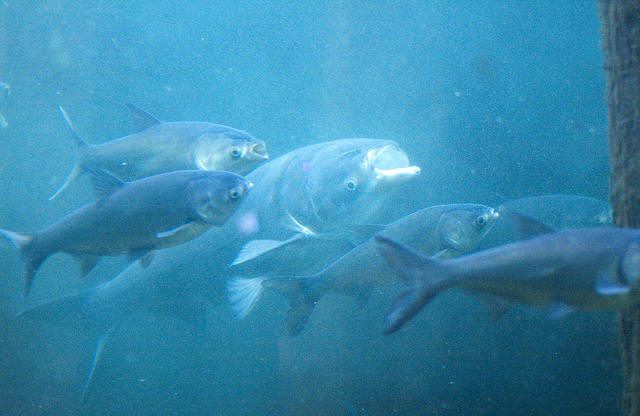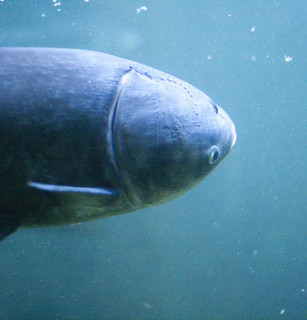Classification
Domain - Eukarya
Kingdom - Animalia
Phylum - Chordata
Class - Actinopterygii
Order - Cypriniformes
Family - Cyprinidae
Genus - Hypophthalmichthys
Species - Hypophthalmichthys nobilis
Want to take a better look at the phylogeny? See the
phylogenetic trees below!
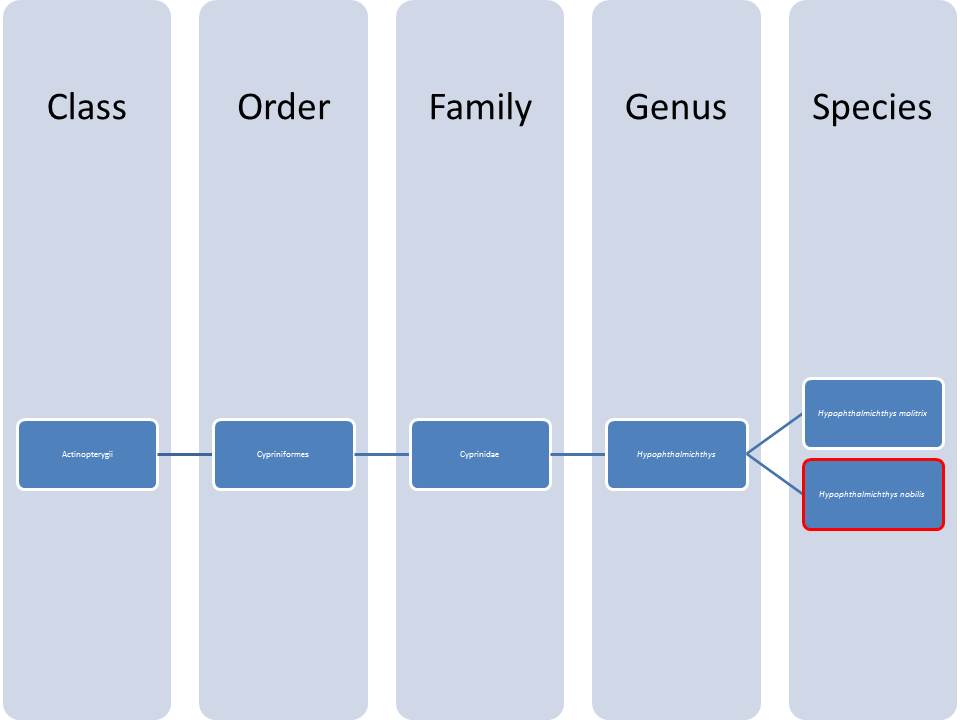
Click on the image to the left to view the Domain, Kingdom, Phylum, and Class.
Click on the image to the right to view the Class, Order, Genus, and Species.
Phylogenetic Tree I Phylogenetic Tree II
To view the first portion of the full scale phylogenetic tree of the Bighead carp click here! To see the second portion of the phylogenetic tree click here.
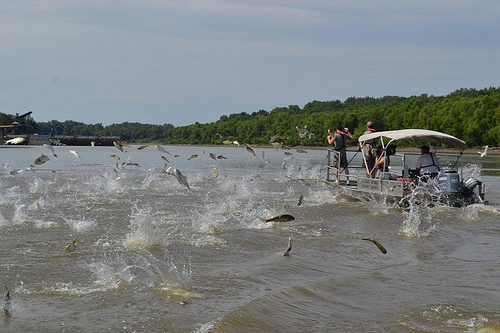 Domain - Eukarya: Organisms, including the
Bighead carp are all found to have the same few traits in this domain.
The traits include the presence of a "true" nucleus, which contains the
DNA. Organisms in this domain also possess membrane bound organelles.
Domain - Eukarya: Organisms, including the
Bighead carp are all found to have the same few traits in this domain.
The traits include the presence of a "true" nucleus, which contains the
DNA. Organisms in this domain also possess membrane bound organelles.
Kingdom - Animalia: The reason Bighead carp belong to the Animalia is because these guys are heterotrophic (they must obtain food from another organism). One distinguishable feature in the Animalia is the lack of alternation of generations that are found in plants and fungi. Another common trait is the lack of a cell wall.
Phylum - Chordata: The word Chordata can be defined as "back cord" and is often attributed as one of the larger animals groups. There are a few characteristics that the organisms in this group all share at some point in their life cycle. The first is the presence of the notochord, a structure that runs the length of the body as the endoskeleton develops in the embryo. A dorsal, tubular nerve chord is present as well. A third common characteristic is the pharyngeal gill slits, which can develop into gills in aquatic chordates like our Bighead carp. A postanal tail and either an endostyle (structure that secretes mucus) or thyroid gland (structure that secretes hormones for metabolism, growth, and development rates. Want to see another example of a Chordate? Click here to find out!
 Class - Actinopterygii: This class consists of
the ray-finned bony fishes. Bighead carp belong to this class for
a few reasons. Bighead carp and others in this grouping have
paired fins and typically possess a homocercal tail. Gills are a
must in order for this group to respirate. The gills are supported
with bony arches and covered by an operculum, which protects the gills
as well as gives streamline capabilities for pumping water. The
system for respiration across the gills is countercurrent exchange.
Organisms in this class also have a swim bladder helping maintain
buoyancy. There are over forty some orders under this class,
adding up to many different species under the Actinopterygii.
Click
here to see another organism under the Actinopterygii.
Class - Actinopterygii: This class consists of
the ray-finned bony fishes. Bighead carp belong to this class for
a few reasons. Bighead carp and others in this grouping have
paired fins and typically possess a homocercal tail. Gills are a
must in order for this group to respirate. The gills are supported
with bony arches and covered by an operculum, which protects the gills
as well as gives streamline capabilities for pumping water. The
system for respiration across the gills is countercurrent exchange.
Organisms in this class also have a swim bladder helping maintain
buoyancy. There are over forty some orders under this class,
adding up to many different species under the Actinopterygii.
Click
here to see another organism under the Actinopterygii.
Order - Cypriniformes: Bighead carp are found
in this order because they have only one dorsal fin and they lack teeth
in their mouth. Minnows and suckers are often associated with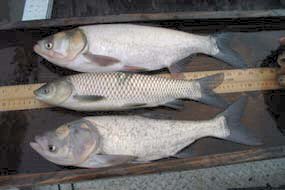 the
word Cypriniformes. To see another example of the Cypriniformes
besides Bighead carp click
here.
the
word Cypriniformes. To see another example of the Cypriniformes
besides Bighead carp click
here.
Family - Cyprinidae: The common interpretation of this family is carp and minnows. This group contains one dorsal fin and an abdominal pelvic fin. This family contains over 2,000 species, all species very diverse being found in many different areas of the world.
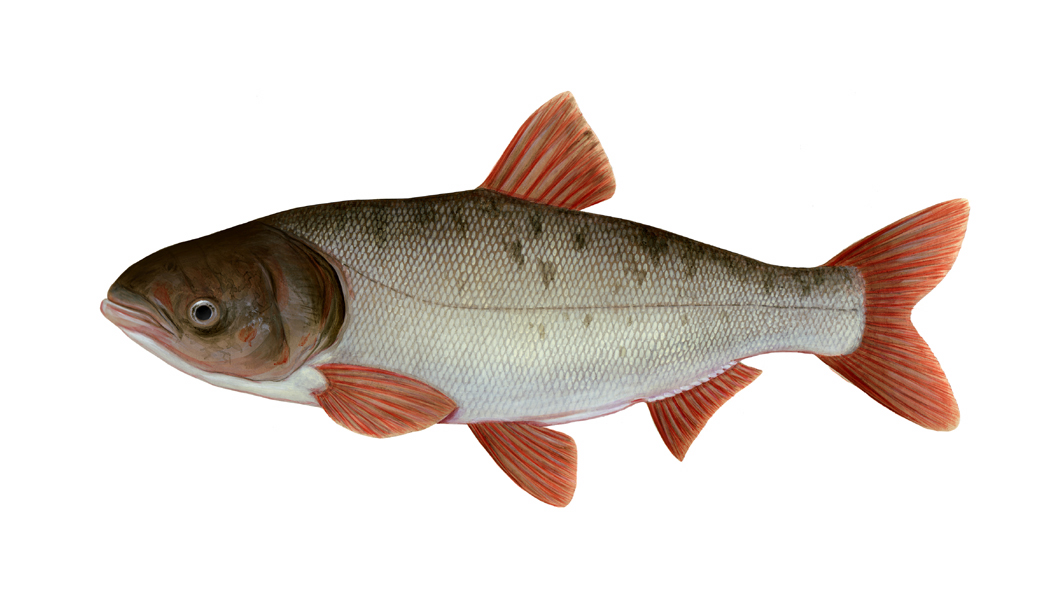 Genus -
Hypophthalmichthys: The genus
Hypophthalmichthys contains only two species;
Hypophthalmichthys molitrix and Hypophthalmichthys nobilis.
Unique characteristics grouped these two species together by
phylogenetic analysis. The taxonomic classification of the Bighead
carp has changed over the years. Orginally, Bighead carp were
known as Leuciscus nobilis. Many years later they were
grouped into the genus Aristichthys, but after further studies
the Silver carp and Bighead carp were grouped into the current genus
Hypophthalmichthys.
Genus -
Hypophthalmichthys: The genus
Hypophthalmichthys contains only two species;
Hypophthalmichthys molitrix and Hypophthalmichthys nobilis.
Unique characteristics grouped these two species together by
phylogenetic analysis. The taxonomic classification of the Bighead
carp has changed over the years. Orginally, Bighead carp were
known as Leuciscus nobilis. Many years later they were
grouped into the genus Aristichthys, but after further studies
the Silver carp and Bighead carp were grouped into the current genus
Hypophthalmichthys.
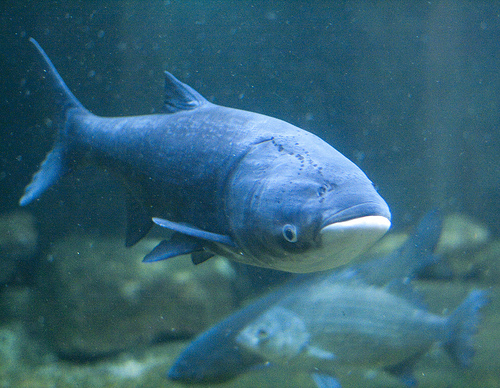 Species - Hypophthalmichthys nobilis: What does this name actually mean? If you break this word into
sections it is easier to understand. Start with the Greek word
hypo. This means under. The next part ophthalm also for the
Greek word opthalmos means eye. The ichthys portion means fish.
When you put the word together you get "under-eye-fish" which you can
properly translate into "underneath-eyed-fish". The word
nobilis means noble in Latin. Finally, put this all together
to translate Hypophthalmichthys nobilis, as
"underneath-eyed-fish noble". Thanks to this unique naming system
called binomial nomenclature, we can come up with names for any
organism. This system prevents the confusing transition in naming
organisms from country to country, and the language is declared a "dead"
language so no changes in the official language can effect binomial
nomenclature. The species Hypophthalmichthys nobilis has
a much larger proportioned head and jaw in comparison. There are a
few other distinct characteristics separating Bighead carp from Silver
carp. Continue through the site to find out what these differences
are!
Species - Hypophthalmichthys nobilis: What does this name actually mean? If you break this word into
sections it is easier to understand. Start with the Greek word
hypo. This means under. The next part ophthalm also for the
Greek word opthalmos means eye. The ichthys portion means fish.
When you put the word together you get "under-eye-fish" which you can
properly translate into "underneath-eyed-fish". The word
nobilis means noble in Latin. Finally, put this all together
to translate Hypophthalmichthys nobilis, as
"underneath-eyed-fish noble". Thanks to this unique naming system
called binomial nomenclature, we can come up with names for any
organism. This system prevents the confusing transition in naming
organisms from country to country, and the language is declared a "dead"
language so no changes in the official language can effect binomial
nomenclature. The species Hypophthalmichthys nobilis has
a much larger proportioned head and jaw in comparison. There are a
few other distinct characteristics separating Bighead carp from Silver
carp. Continue through the site to find out what these differences
are!
Now that you know how to classify Hypophthalmichthys nobilis click here to see the habitat and distribution of where this interesting organism can live!
